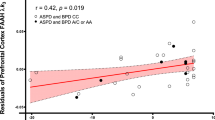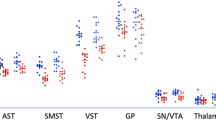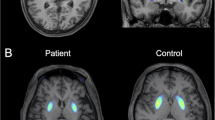Abstract
Although behavioral addictions share many clinical features with drug addictions, they show strikingly large variation in their behavioral phenotypes (such as in uncontrollable gambling or eating). Neurotransmitter function in behavioral addictions is poorly understood, but has important implications in understanding its relationship with substance use disorders and underlying mechanisms of therapeutic efficacy. Here, we compare opioid and dopamine function between two behavioral addiction phenotypes: pathological gambling (PG) and binge eating disorder (BED). Thirty-nine participants (15 PG, 7 BED, and 17 controls) were scanned with [11C]carfentanil and [18F]fluorodopa positron emission tomography using a high-resolution scanner. Binding potentials relative to non-displaceable binding (BPND) for [11C]carfentanil and influx rate constant (Ki) values for [18F]fluorodopa were analyzed with region-of-interest and whole-brain voxel-by-voxel analyses. BED subjects showed widespread reductions in [11C]carfentanil BPND in multiple subcortical and cortical brain regions and in striatal [18F]fluorodopa Ki compared with controls. In PG patients, [11C]carfentanil BPND was reduced in the anterior cingulate with no differences in [18F]fluorodopa Ki compared with controls. In the nucleus accumbens, a key region involved in reward processing, [11C]Carfentanil BPND was 30–34% lower and [18F]fluorodopa Ki was 20% lower in BED compared with PG and controls (p<0.002). BED and PG are thus dissociable as a function of dopaminergic and opioidergic neurotransmission. Compared with PG, BED patients show widespread losses of mu-opioid receptor availability together with presynaptic dopaminergic defects. These findings highlight the heterogeneity underlying the subtypes of addiction and indicate differential mechanisms in the expression of pathological behaviors and responses to treatment.
Similar content being viewed by others
Log in or create a free account to read this content
Gain free access to this article, as well as selected content from this journal and more on nature.com
or
References
Alakurtti K, Johansson JJ, Joutsa J, Laine M, Bäckman L, Nyberg L et al (2015). Long-term test-retest reliability of striatal and extrastriatal dopamine D2/3 receptor binding: study with [(11)C]raclopride and high-resolution PET. J Cereb Blood Flow Metab 35: 1199–1205.
Badiani A, Belin D, Epstein D, Calu D, Shaham Y (2011). Opiate versus psychostimulant addiction: the differences do matter. Nat Rev Neurosci 12: 685–700.
Berridge KC, Robinson TE, Aldridge JW (2009). Dissecting components of reward: 'liking', 'wanting', and learning. Curr Opin Pharmacol 9: 65–73.
Blanco C, Hanania J, Petry NM, Wall MM, Wang S, Jin CJ et al (2015). Towards a comprehensive developmental model of pathological gambling. Addiction 110: 1340–1351.
Bloomfield MA, Pepper F, Egerton A, Demjaha A, Tomasi G, Mouchlianitis E et al (2014). Dopamine function in cigarette smokers: an [(1)(8)F]-DOPA PET study. Neuropsychopharmacology 39: 2397–2404.
Boileau I, Payer D, Chugani B, Lobo D, Behzadi A, Rusjan PM et al (2013). The D2/3 dopamine receptor in pathological gambling: a positron emission tomography study with [11C]-(+)-propyl-hexahydro-naphtho-oxazin and [11C]raclopride. Addiction 108: 953–963.
Boileau I, Payer D, Chugani B, Lobo DS, Houle S, Wilson AA et al (2014). In vivo evidence for greater amphetamine-induced dopamine release in pathological gambling: a positron emission tomography study with [(11)C]-(+)-PHNO. Mol Psychiatry 19: 1305–1313.
Brownley KA, Berkman ND, Peat CM, Lohr KN, Cullen KE, Bann CM et al (2016). Binge-eating disorder in adults: a systematic review and meta-analysis. Ann Intern Med 165: 409–420.
Cambridge VC, Ziauddeen H, Nathan PJ, Subramaniam N, Dodds C, Chamberlain SR et al (2013). Neural and behavioral effects of a novel mu opioid receptor antagonist in binge-eating obese people. Biol Psychiatry 73: 887–894.
Clark L, Stokes PR, Wu K, Michalczuk R, Benecke A, Watson BJ et al (2012). Striatal dopamine D2/D3 receptor binding in pathological gambling is correlated with mood-related impulsivity. Neuroimage 63: 40–46.
de Jong HW, van Velden FH, Kloet RW, Buijs FL, Boellaard R, Lammertsma AA (2007). Performance evaluation of the ECAT HRRT: an LSO-LYSO double layer high resolution, high sensitivity scanner. Phys Med Biol 52: 1505–1526.
Desikan RS, Ségonne F, Fischl B, Quinn BT, Dickerson BC, Blacker D et al (2006). An automated labeling system for subdividing the human cerebral cortex on MRI scans into gyral based regions of interest. Neuroimage 31: 968–980.
Fischl B, Salat DH, Busa E, Albert M, Dieterich M, Haselgrove C et al (2002). Whole brain segmentation: automated labeling of neuroanatomical structures in the human brain. Neuron 33: 341–355.
Forsback S, Eskola O, Bergman J, Haaparanta M, Solin O (2009). Alternative solvents for electrophilic synthesis of 6-[18F]fluoro-L-DOPA. J Labelled Combd Rad 52: 286–288.
Giuliano C, Cottone P (2015). The role of the opioid system in binge eating disorder. CNS Spectr 20: 537–545.
Grant JE, Kim SW, Hartman BK (2008). A double-blind, placebo-controlled study of the opiate antagonist naltrexone in the treatment of pathological gambling urges. J Clin Psychiatry 69: 783–789.
Grant JE, Odlaug BL, Potenza MN, Hollander E, Kim SW (2010a). Nalmefene in the treatment of pathological gambling: multicentre, double-blind, placebo-controlled study. Br J Psychiatry 197: 330–331.
Grant JE, Potenza MN, Hollander E, Cunningham-Williams R, Nurminen T, Smits G et al (2006). Multicenter investigation of the opioid antagonist nalmefene in the treatment of pathological gambling. Am J Psychiatry 163: 303–312.
Grant JE, Potenza MN, Weinstein A, Gorelick DA (2010b). Introduction to behavioral addictions. Am J Drug Alcohol Abuse 36: 233–241.
Gunn RN, Lammertsma AA, Hume SP, Cunningham VJ (1997). Parametric imaging of ligand-receptor binding in PET using a simplified reference region model. Neuroimage 6: 279–287.
Haber SN, Knutson B (2010). The reward circuit: linking primate anatomy and human imaging. Neuropsychopharmacology 35: 4–26.
Heinz A, Reimold M, Wrase J, Hermann D, Croissant B, Mundle G et al (2005). Correlation of stable elevations in striatal mu-opioid receptor availability in detoxified alcoholic patients with alcohol craving: a positron emission tomography study using carbon 11-labeled carfentanil. Arch General Psychiatry 62: 57–64.
Hirvonen J, Aalto S, Hagelberg N, Maksimow A, Ingman K, Oikonen V et al (2009). Measurement of central mu-opioid receptor binding in vivo with PET and [11C]carfentanil: a test-retest study in healthy subjects. Eur J Nucl Med Mol Imaging 36: 275–286.
Joutsa J, Johansson J, Niemelä S, Ollikainen A, Hirvonen MM, Piepponen P et al (2012). Mesolimbic dopamine release is linked to symptom severity in pathological gambling. Neuroimage 60: 1992–1999.
Karlsson HK, Tuulari JJ, Tuominen L, Hirvonen J, Honka H, Parkkola R et al (2015). Weight loss after bariatric surgery normalizes brain opioid receptors in morbid obesity. Mol Psychiatry 21: 1057–1062.
Keller SH, Sibomana M, Olesen OV, Svarer C, Holm S, Andersen FL et al (2012). Methods for motion correction evaluation using 18F-FDG human brain scans on a high-resolution PET scanner. J Nucl Med 53: 495–504.
Kessler RC, Berglund PA, Chiu WT, Deitz AC, Hudson JI, Shahly V et al (2013). The prevalence and correlates of binge eating disorder in the World Health Organization World Mental Health Surveys. Biol Psychiatry 73: 904–914.
Kessler RC, Hwang I, LaBrie R, Petukhova M, Sampson NA, Winters KC et al (2008). DSM-IV pathological gambling in the National Comorbidity Survey Replication. Psychol Med 38: 1351–1360.
Kienast T, Schlagenhauf F, Rapp MA, Wrase J, Daig I, Buchholz HG et al (2013). Dopamine-modulated aversive emotion processing fails in alcohol-dependent patients. Pharmacopsychiatry 46: 130–136.
Kim SW, Grant JE, Adson DE, Shin YC (2001). Double-blind naltrexone and placebo comparison study in the treatment of pathological gambling. Biol Psychiatry 49: 914–921.
Kovanen L, Basnet S, Castrén S, Pankakoski M, Saarikoski ST, Partonen T et al (2016). A randomised, double-blind, placebo-controlled trial of as-needed naltrexone in the treatment of pathological gambling. Eur Addict Res 22: 70–79.
Li C, Sugam JA, Lowery-Gionta EG, McElligott ZA, McCall NM, Lopez AJ et al (2016). Mu opioid receptor modulation of dopamine neurons in the periaqueductal gray/dorsal raphe: a role in regulation of pain. Neuropsychopharmacology 41: 2122–2132.
Li Y, van den Pol AN (2008). Mu-opioid receptor-mediated depression of the hypothalamic hypocretin/orexin arousalsystem. J Neurosci 28: 2814–2819.
Linnet J, Mouridsen K, Peterson E, Møller A, Doudet DJ, Gjedde A (2012). Striatal dopamine release codes uncertainty in pathological gambling. Psychiatry Res 204: 55–60.
McElroy SL, Guerdjikova AI, Blom TJ, Crow SJ, Memisoglu A, Silverman BL et al (2013). A placebo-controlled pilot study of the novel opioid receptor antagonist ALKS-33 in binge eating disorder. Int J Eating Disord 46: 239–245.
McElroy SL, Hudson JI, Mitchell JE, Wilfley D, Ferreira-Cornwell MC, Gao J et al (2015). Efficacy and safety of lisdexamfetamine for treatment of adults with moderate to severe binge-eating disorder: a randomized clinical trial. JAMA Psychiatry 72: 235–246.
Mick I, Myers J, Ramos AC, Stokes PR, Erritzoe D, Colasanti A et al (2015). Blunted endogenous opioid release following an oral amphetamine challenge in pathological gamblers. Neuropsychopharmacology 41: 1742–1750.
Patlak CS, Blasberg RG (1985). Graphical evaluation of blood-to-brain transfer constants from multiple-time uptake data. J Cereb Blood Flow Metab 5: 584–590.
Potenza MN, Xian H, Shah K, Scherrer JF, Eisen SA (2005). Shared genetic contributions to pathological gambling and major depression in men. Arch Gen Psychiatry 62: 1015–1021.
Robbins TW, Clark L (2015). Behavioral addictions. Curr Opin Neurobiol 30: 66–72.
Rosner S, Hackl-Herrwerth A, Leucht S, Vecchi S, Srisurapanont M, Soyka M (2010). Opioid antagonists for alcohol dependence. Cochrane Database Syst Rev CD001867.
Toneatto T, Brands B, Selby P (2009). A randomized, double-blind, placebo-controlled trial of naltrexone in the treatment of concurrent alcohol use disorder and pathological gambling. Am J Addict 18: 219–225.
Volkow ND, Tomasi D, Wang GJ, Logan J, Alexoff DL, Jayne M et al (2014). Stimulant-induced dopamine increases are markedly blunted in active cocaine abusers. Mol Psychiatry 19: 1037–1043.
Voon V (2015). Cognitive biases in binge eating disorder: the hijacking of decision making. CNS Spectr 20: 566–573.
Wang GJ, Geliebter A, Volkow ND, Telang FW, Logan J, Jayne MC et al (2011). Enhanced striatal dopamine release during food stimulation in binge eating disorder. Obesity 19: 1601–1608.
Weintraub D, Koester J, Potenza MN, Siderowf AD, Stacy M, Voon V et al (2010). Impulse control disorders in Parkinson disease: a cross-sectional study of 3090 patients. Arch Neurol 67: 589–595.
Woods RP, Grafton ST, Holmes CJ, Cherry SR, Mazziotta JC (1998). Automated image registration: I. General methods and intrasubject, intramodality validation. J Comput Assist Tomogr 22: 139–152.
Wu JC, Bell K, Najafi A, Widmark C, Keator D, Tang C et al (1997). Decreasing striatal 6-FDOPA uptake with increasing duration of cocaine withdrawal. Neuropsychopharmacology 17: 402–409.
Yau YH, Potenza MN (2015). Gambling disorder and other behavioral addictions: recognition and treatment. Harv Rev Psychiatry 23: 134–146.
Ziauddeen H, Chamberlain SR, Nathan PJ, Koch A, Maltby K, Bush M et al (2013). Effects of the mu-opioid receptor antagonist GSK1521498 on hedonic and consummatory eating behaviour: a proof of mechanism study in binge-eating obese subjects. Mol Psychiatry 18: 1287–1293.
Zubieta JK, Gorelick DA, Stauffer R, Ravert HT, Dannals RF, Frost JJ (1996). Increased mu opioid receptor binding detected by PET in cocaine-dependent men is associated with cocaine craving. NatMed 2: 1225–1229.
Acknowledgements
We thank the personnel of the Turku PET Centre for their expertise and assistance in PET and MRI imaging.
Author information
Authors and Affiliations
Corresponding author
Additional information
Supplementary Information accompanies the paper on the Neuropsychopharmacology website
Supplementary information
PowerPoint slides
Rights and permissions
About this article
Cite this article
Majuri, J., Joutsa, J., Johansson, J. et al. Dopamine and Opioid Neurotransmission in Behavioral Addictions: A Comparative PET Study in Pathological Gambling and Binge Eating. Neuropsychopharmacol 42, 1169–1177 (2017). https://doi.org/10.1038/npp.2016.265
Received:
Revised:
Accepted:
Published:
Issue date:
DOI: https://doi.org/10.1038/npp.2016.265
This article is cited by
-
Endogenous mu-opioid modulation of social connection in humans: a systematic review and meta-analysis
Translational Psychiatry (2024)
-
Reward and Inhibitory Control as Mechanisms and Treatment Targets for Binge Eating Disorder
Current Psychiatry Reports (2024)
-
A literature review of dopamine in binge eating
Journal of Eating Disorders (2022)
-
Obesity risk is associated with altered cerebral glucose metabolism and decreased μ-opioid and CB1 receptor availability
International Journal of Obesity (2022)
-
Neuroimaging of Dopamine Transporter Density in the Striatum of Disordered Gamblers
Journal of Gambling Studies (2022)



